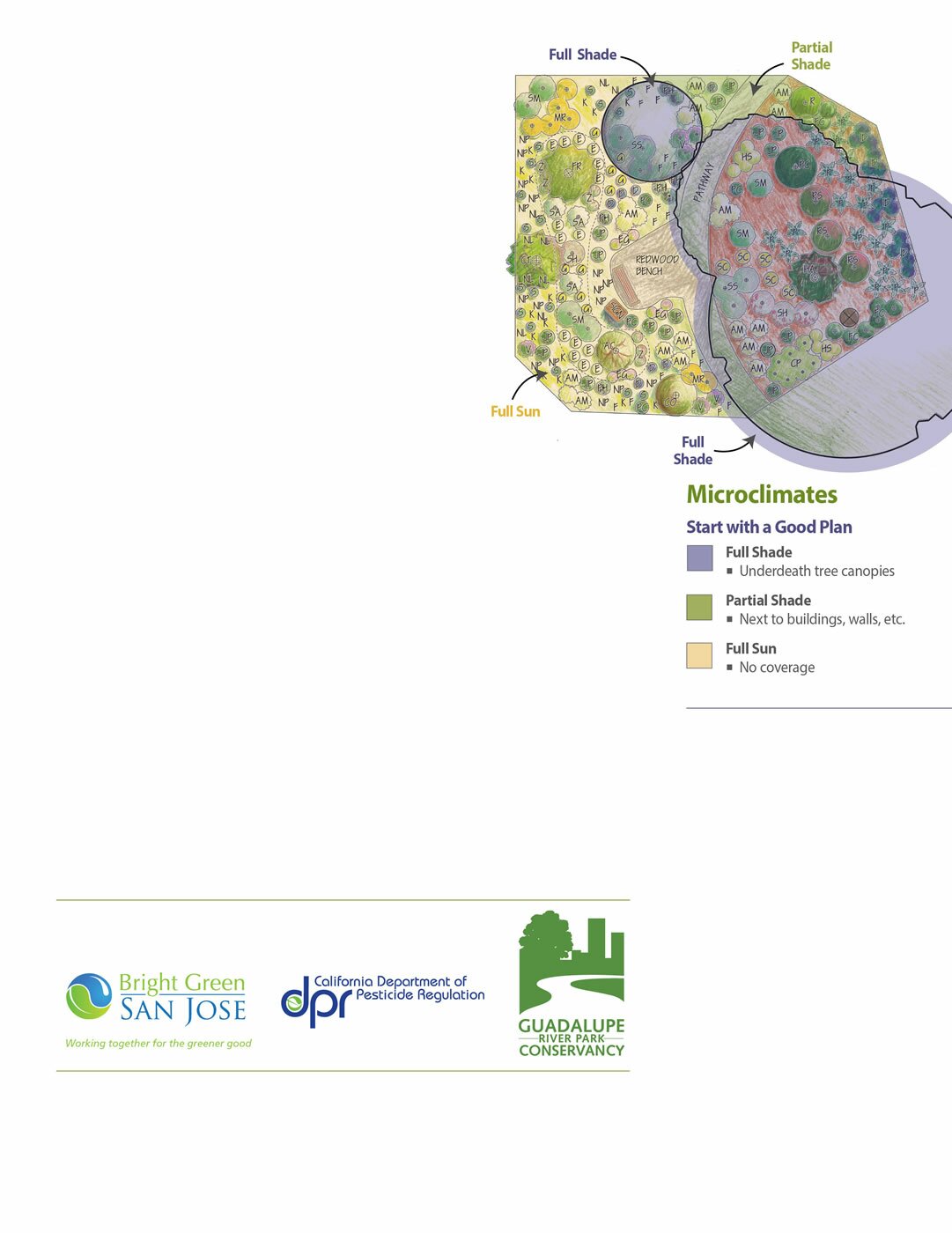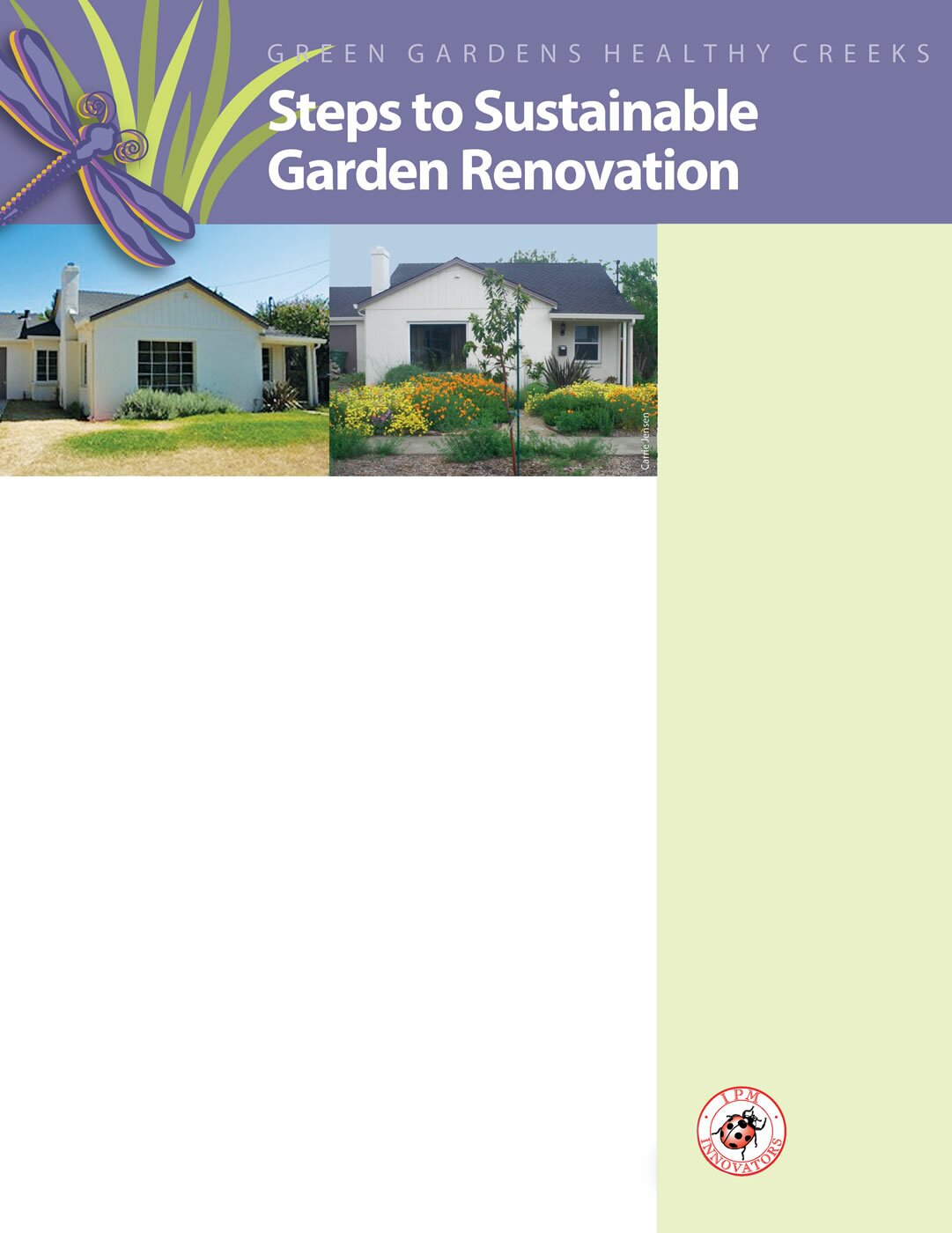Before Renovation
1. Determine the Key Functions of Your Yard
How do you want to enjoy and use your yard? Functional elements might include wildlife habitat, a relaxation area, screening for privacy or noise reduction, a kids play area, pet friendly space, or others.
2. Analyze Your Site Conditions
- Evaluate your soil: See the Start with the Healthy Soil factsheet.
- Map your property and identify:
- Microclimates corresponding to different sun, shade, wind, and other factors.
- Best places for functional areas.
- Which plants you want to keep and/or remove.
- Location of slopes and evidence of erosion.
- Water paths through the landscape, including high and low spots and opportunities to soak up rainwater (See www.waterboards.ca.gov/stormfilm/).
- Location and zones of any existing automatic irrigation system.
3. Make a Plan
- Include information and solutions from item 2 above.
- Consider which lawn areas to remove or minimize.
- Incorporate drought tolerant, California native plants. Consult the Santa Clara Valley Water District’s Plant Guide and local nursery professionals for advice.
- Plan for amendment, irrigation, drainage, and appropriate planting.
- Consider incorporating rainwater capture or greywater irrigation.
- Contact a professional for help, if needed.
4. Take Advantage of Local Rebates
Rebates are available from the Santa Clara Valley Water District for converting high water use landscape and/or upgrading inefficient irrigation hardware. A pre-inspection and a written “Notice to Proceed” are required before starting work. For more information, call (408) 265-2554 or visit www.valleywater.org.
After Renovation
Getting Help
If you lack the skills, time or desire to take on a renovation yourself, hiring a qualified landscape designer or contractor is a good investment.
What to look for:
A commitment to sustainability:
Ask if the professional or their staff is qualified by Bay-Friendly, Green Gardener, or other sustainable landscape training programs. Such landscape professionals can be found at www.bayfriendlycoalition.org and www.mywatershedwatch.org
Check licenses:
CA law requires a licensed contractor to perform any job costing over $500 for time and materials.
Get references:
Ask current or past clients about reliability, professionalism, and quality of work.
Look at their work:
Ask for addresses where you can see their work firsthand.
Get Detailed Estimates:
Each aspect of work should have its own line item and estimated cost.
City of San José:
the IPM Innovator
Award Winner 2010

5. Grade the Site
- Call 811 to locate utilities at least 2-14 working days before digging!
- Remove lawn from areas you won't use (see sidebar below).
- Protect your topsoil by only grading for important reasons such as retaining water, preventing erosion, and improving drainage.
- Use excavated soil to build berms or mounds.
- Build swales and rain gardens, and direct roof downspouts to them.
- During construction, use straw wattles to protect gutters and storm drains from sediment runoff.
6. Amend the Soil
- Amend the soil with high quality compost to improve infiltration and moisture retention. See the Compost for Healthy Soil and Plants factsheet.
7. Install Hardscape and Drainage Features
- Use paver blocks, stones, gravel, decomposed granite, pervious concrete, or other pervious materials for patios and walkways.
- Break up old concrete patios and use pieces for stepping stones or planter walls.
- Use native stones and recycled materials for walls, paths, or dry streambed.
8. Use Climate-appropriate Plants
- Group plants in separate water-use zones according to their watering needs and unique microclimate preferences.
- Put the right plant in the right place. Give plants enough space to grow to their mature full size. See the Right Plant for the Right Place factsheet.
9. Water Wisely
- Retrofit sprinklers to drip irrigation, or water plants by hand during the establishment period.
- Use mulch to hold in soil moisture and prevent weed growth. See the Mulch for Healthier Soil and Plants factsheet.
- Install a timer or automatic controller with a rain sensor.
- Schedule irrigation according to soil type, plant’s water needs, and the weather. See the Water Wisely factsheet.
10. Enjoy your Sustainable Landscape!
Funding for this project has been provided in full or in part through a grant awarded by the Department of Pesticide Regulation (DPR). The contents of this document do not necessarily reflect the views and policies of the Department of Pesticide Regulation, nor does mention of trade names or commercial products constitute endorsement or recommendation for use.
For more information about sustainable gardening, please visit www.bayareaecogardens.org
Remove Thirsty Lawns by Sheet Mulching
Sheet mulching is simply laying cardboard or newspaper over an existing lawn and then topping it with layers of compost and woodchip mulch. Sheet mulching saves time and money because plants are easily installed directly into the mulch.
Highly invasive plants such as Bermuda grass, kikuyu, oxalis, and blackberries must be removed before sheet mulching or they will come back up through the cardboard and mulch!
Case studies and easy-to-follow instructions on removing turf with sheet mulching are available at www.loseyourlawn.org.
